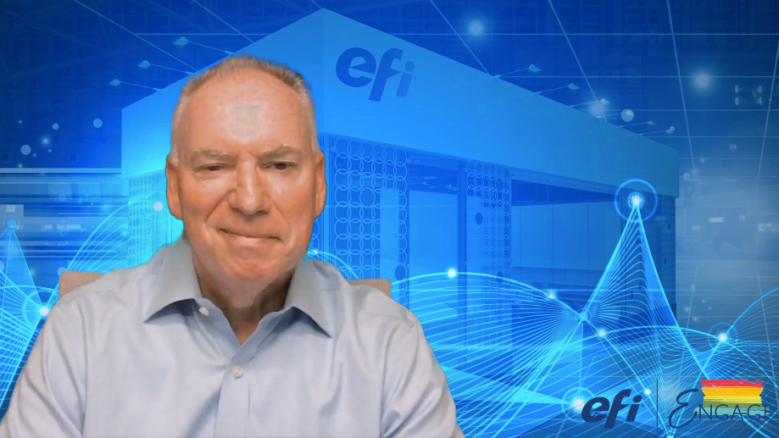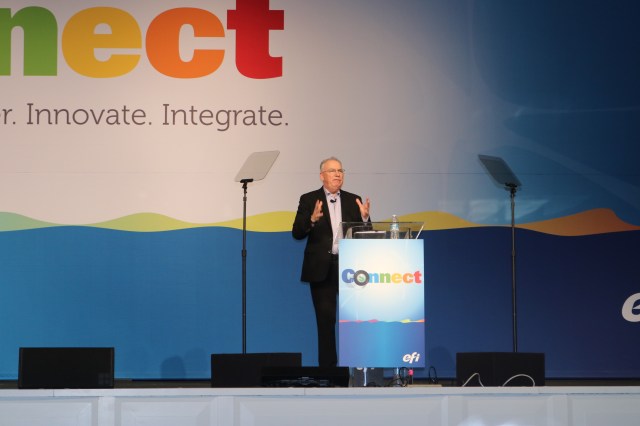
As the global print industry perseveres to stay relevant through a pandemic, EFI CEO Jeff Jacobson has taken to the company’s Engage virtual event to provide thought leadership on being agile for the future.
According to Jacobson, pivoting to profitability means being agile in a turbulent environment. He said changes that we have seen over the past year may have been daunting, but together as an industry, need to embrace change to benefit ourselves, customers and communities.
“The world is very different from the time I spoke to you last January. We were gathered in person at that time in Las Vegas but in 2021, the coronavirus has dictated having a virtual event instead,” he said during the keynote presentation.
“Just as we have seen with countless other in-person events, including our major industry tradeshows such as drupa and Printing United, the changes between then and now are stark. The hopes we see coming into fruition now are the efforts to create and implement vaccines.
“I am a realist and an optimist, and I am hopeful for the future. I am encouraged by the fact that vaccines are being distributed and this will help us move forward on a path back to normalcy.
“But when this pandemic ends, things won’t go back 100 per cent to the way it was before. Many communities that did not have adequate digital services have by now hopefully received access that they did not before, helping to shrink the digital divide.
“Many people that have been working from home during the pandemic might not come back to working in an office, and it may be for workers who must report in person only. The working world may come to an age where a major temporary disruption does not mean a major loss in productivity.”
According to Jacobson, so much of printing is tied to marketing and an important segment that it serves with display graphics has been severely impacted by the pandemic.
On the other hand, he mentioned that there are some areas where the pandemic has increased demand.
“Short-run, on-demand packaging and e-commerce, for example have driven a 40 per cent plus increase in output for users of EFI’s Nozomi single-pass corrugated printers,” he said.
“Countless EFI customers who lost traditional work producing promotional signage recovered some of their revenue producing urgently needed social distancing graphics and divisional graphics, such a shields and dividers, as well as cloth masks.
“That is what this industry has always been about – we come together when we are challenged and needed the most.”
Jacobson also spoke about the tough stories in print, with many businesses having to make the tough decisions related to the continuation of their operations.
“The industry witnessed revenue declines in sales, especially for the months of March and April 2020, in access of 50 per cent in some cases. With the changes coming to minimise the virus, we can start to look forward to not only a safer world but to some manner of global economic recovery in which print demand begins to grow once again,” he said.
Jacobson also attributed findings from Printing United Alliance chief economist Andy Paparozzi, who said November and December of 2020 showed YoY growth in the US.
“This is a very small increase in activity that I’m sure we are all happy to see considering the circumstances. More than half the jobs lost during March and April last year have in fact been recovered,” Jacobson mentioned.
He also said the biggest percentage of forecasted investments have been made in software solutions, information systems and digital infrastructure, making printing businesses leaner, more efficient and profitable.
“This will continue to be a key area of investment for recovery,” Jacobson added.
“In the US, industry sales are expected to grow at 2.5 per cent and four per cent next year. While that is a better rate than we have seen in the past, it is also coming off one of the weakest years the industry has seen. It sends a clear message – prepare now for a recovery that is coming as we move away from the pandemic.
“High volume print manufacturing is more relevant than ever. It’s more applicable because following the pandemic, we are seeing an increase in industrial applications such as corrugated packaging and textiles and we will see this migrate into other markets including display graphics.”
Moving forward, Jacobson said the future is in digital.
“It is more important than ever to adapt because the agility and technological foresight of this industry has enabled us to be essential and relevant. We view it as incumbent in our team at EFI to help you prepare for what is needed and ahead for your business,” he said.
“Digital has meant that print is not a one size fits all proposition. We can pursue customisation, personalisation and regionalisation of print in ways that help customers achieve targeted growth. Digital print is more and more about giving the customer what they want, and when they want it. This is what we’ve all seen with the Amazon effect, and it will only continue.
“For example, we can now take plain brown corrugated boxes and personalise them into advertising media. Digital can also mean creating products closer to the point of need. As different parts of the world taps into the opportunity that this creates, we can see the realisation of pent-up opportunity.
“EFI has already seen early movement in this area. For example, European fashion brands are decorating accessories and footwear and staying on trend with shorter turn-around times using digital print locally instead of relying on factory orders abroad.”
In addition, a part of this future is enabling both virtual and print workflows as well. Jacobson said it also involves robust e-commerce which is no longer an after-thought.
“We know we have a responsibility to create solutions that allow you to capture a growing volume of new and repeat business online,” he said.
“That level of digital capability extends to the cloud. More of your customers’ business takes place in the cloud, and increasingly is becoming a more flexible place for you to conduct your business as well.
“Some of the biggest enhancements you will see from us at EFI is in our services. Remote services are more prevalent than ever as the pandemic has forced us to find new ways of working especially with restrictions we have all faced with travel. COVID-19 has forced us to all take our digital capabilities to an enhanced new level.
“Above all, when you think of digital and print, consider what it means in the near and long-term future.”
Comment below to have your say on this story.
If you have a news story or tip-off, get in touch at editorial@sprinter.com.au.
Sign up to the Sprinter newsletter



